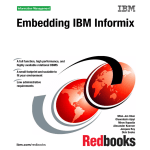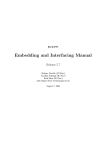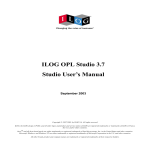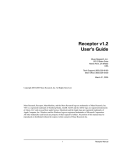Download ECL PS : A Platform for Constraint Logic Programming
Transcript
ECLiPSe : A Platform for Constraint Logic Programming Mark Wallace, Stefano Novello, Joachim Schimpf Contact address: IC-Parc, William Penney Laboratory, Imperial College, LONDON SW7 2AZ. email: [email protected] August 1997 Abstract This paper introduces the Constraint Logic Programming (CLP) platform ECLi PSe . ECLi PSe is designed to be more than an implementation of CLP: it also supports mathematical programming and stochastic programming techniques. The crucial advantage of ECLi PSe is that it enables the programmer to use a combination of algorithms appropriate to the application at hand. This benet results from the ECLi PSe facility to support ne-grained hybridisation. ECLi PSe is designed for solving dicult "combinatorial" industrial problems in the areas of planning, scheduling and resource allocation. The platform oers a conceptual modelling language for specifying the problem clearly and simply, in a way that is neutral as to the algorithm which will be used to solve it. Based on the conceptual model it is easy to construct alternative design models, also expressed in ECLi PSe . A design model is a runnable program, whose execution in ECLi PSe employs a specic combination of algorithms. Thus the platform supports experimentation with dierent hybrid algorithms. Technically the dierent classes of algorithms mentioned above have two aspects: constraint handling, and search. Various dierent constraint handling facilities are available as ECLi PSe libraries. These include nite domain propagation, interval propagation and linear constraint solving. In ECLi PSe the same constraint can be treated concurrently by several dierent handlers. With regard to search behaviour, CLP and also mathematical programming typically impose new constraints at lower levels in the search tree. By contrast, stochastic techniques search for good solutions by locally repairing an original solution, and repeating the process again and again. ECLi PSe supports both kinds of search, and allows them to be combined into hybrid search techniques. 1 Introduction: The ECLiPSe Philosophy The rst generation of constraint programming languages focussed on a single technique: constraint propagation, as described in section 4 of [Wal97]. Whilst constraint propagation has proved itself on a variety of applications, it cannot alone suce to eciently produce solutions for typical practical industrial problems. Over the years Operations Researchers have designed highly ecient algorithms for several classes of problems, such as set partitioning, matching, knapsack, and network ow problems, using techniques based on Mixed Integer Programming (MIP). More recently stochastic techniques, such as Simulated Annealing, have achieved striking results on optimisation problems such as the travelling salesman problem.1 ECLi PSe is designed to take advantage of all these results, by supporting industrial scale MIP functionality, and stochastic techniques, as well as constraint propagation and solving. 1 The travelling salesman problem is to nd the shortest route which starts at a certain point, visits a given set of destinations (customers), and returns to the starting point at the end. 1 More importantly, real industrial problems seldom t into a specic class: the pure travelling salesman problem rarely comes up in real life because there are typically many salesmen available to cover the dierent customers, certain customers can only be visited at certain times of day, also roads are busier at certain times of day so the journey time may vary with the time of day, and anyway the poor salesmen need some time to rest - they can't usually complete their circuits before lunchtime! These \side constraints" may belong to another problem class - such as the class of set covering problems, or scheduling problems. Industrial problems typically have constraints that belong to dierent problem classes they are in a sense \hybrid". Accordingly it is not only necessary to oer a wide choice of algorithms for solving such problems, but also the facility to mix and match the algorithms, i.e. to build hybrid algorithms. ECLi PSe is designed to support the fast development of specic hybrid algorithms tuned to the problem at hand. It is not assumed that the rst algorithm implemented by the application developer is guaranteed to be the best one: rather ECLi PSe provides a platform supporting experimentation with dierent hybrid algorithms until an appropriate one is found which suits the particular features of the application. In the next section we shall explore ECLi PSe as a problem modelling language. We distinguish two kinds of model: the conceptual model, which captures the problem specication, and the design model, which is tuned for ecient solving on a computer. ECLi PSe is designed to support both kinds of models, and the mapping between them. In the following two sections we shall examine the ECLi PSe facilities for handling constraints. In [Wal97] we encountered dierent kinds of constraints - primitive constraints, propagation constraints and constraint agents. ECLi PSe supports various classes of built-in constraints, both primitive constraints and propagation constraints. ECLi PSe also allows complex constraints and constraint behaviours to be constructed from the built-in classes, thus supporting constraint agents. After constraint handling we return to the second major aspect of problem solving: the search for solutions. We will separate this discussion into two subsections. The rst is concerned with constructive search, and the second with repair-based search. Constructive search explores the consequences of making choices for decision variables one-at-a-time. Each choice reduces the set of viable choices for the remaining decisions. By contrast repair-based search explores the consequences, not of making decisions, but of changing them. In this case the new choice is typically compared with the previous one, in the context of other suggested choices for the other decision variables. Initially it is not expected that the suggested choices are necessarily consistent with the constraints. The idea of changing the choices is to reduce the number of constraint violations until all the constraints are nally satised. Finally there is a brief section on the ECLi PSe system, its external communication facilities, embeddability, documentation and how to obtain the system. 2 ECLiPSe as a Modelling Language 2.1 Overview of ECLiPSe as a Modelling Language ECLi PSe is tailored for solving combinatorial problems. Such problems are characterised by a set of decisions which have to be made (where each decision has a set of alternative choices) and a set of constraints between the decisions (so a certain choice for one decision may preclude, or entail, certain choices for other decisions). In ECLi PSe each decision is modelled by a variable, and each choice by a possible value for that variable. The constraints are modelled by relations between the variables. As an example consider the map colouring program, with four countries to colour. This program was also used to illustrate constraint logic programming in [Wal97]. ECLi PSe is a constraint logic programming language, and it uses the same syntax as Prolog. Hopefully this syntax will already be familiar to many readers. At the same time, we also hope that any readers who have suered from the limitations of Prolog will not conclude that ECLi PSe therefore suers from the same limitations! The problem involves four decisions, one for each country. These are modelled by the variables A, B , C and D. Countries is just a name for the list of four variables. Each 2 :- lib(apply_macros). coloured(Countries) :Countries = [A,B,C,D], applist(value,Countries), ne(A,B), ne(A,C), ne(A,D), ne(B,C), ne(B,D), ne(C,D). value(red). value(green). value(blue). Figure 1: A Generic Logic Program for Map Colouring decision variable, in this problem, has the same set of choices, modelled as possible values for the variables (red, green and blue). There are six constraints, each of which is modelled by the same relation (ne meaning not equal to). The rst command :- lib(apply_macros). loads an ECLi PSe library. Much of the functionality of ECLi PSe is held in dierent libraries, some of which will be introduced in the next section. The library apply macros holds the denition of the applist predicate, which applies a predicate to each element of a list. applist(value,Countries) is equivalent to value(A), value(B), value(C), value(D). 2.2 Why Logic Programming The requirements on ECLi PSe are of two kinds: to enable such problems to be modelled simply and naturally; and to enable the resulting problem model to be solved eciently. The separation of modelling and solving is supported in ECLi PSe by distinguishing the conceptual model, expressed as a \pure" logical ECLi PSe program, from the design model, which is constructed from the conceptual model by adding control to the ECLi PSe program. This combination of requirements is dicult to satisfy - perhaps impossible if a completely general modelling language is required, suitable for every kind of application. However the applications for which ECLi PSe is designed are decision support applications involving combinatorial problems. Logic programming is peculiarly apt for modelling problems of this kind for two reasons. It is based on relations It supports logical variables Since every combinatorial problem is naturally modelled as a set of variables and a set of constraints (i.e. relations) on those variables, the facilities of logic programming precisely match the requirements for modelling combinatorial problems. Every predicate in a logic program denes a relation, either explicitly as a set of facts, or implicitly in terms of rules. We can recall the example from the [Wal97]. The predicate meat was dened by two facts: meat(beef,5). meat(pork,7). whilst the predicate main (meaning \main course") was dened by two rules: main(M,I) :- meat(M,I). main(M,I) :- fish(M,I). Variables in logic programming are logical variables. Thus it is entirely natural to initialise the problem variables (for example by writing Countries = [A;B; C; D]) and then to constrain them (for example by writing ne(A;B ) and so on). We briey compare ECLi PSe as a modelling language with formal specication languages, mathematical modelling languages, mainstream programming languages and object oriented languages. 3 2.2.1 Formal Specication Languages Formal specication language are designed for formality, but not for execution. Consequently they include constructs, such as universal quantication, which are precisely dened but are not constructive. In other words there are constructs which cannot be mapped onto any (practical) algorithm. Luckily the class of problems for which ECLi PSe is designed have a nite set of decision variables each of which admits only nitely many alternatives. Consequently it is only necessary to support a restricted form of logic2 which is easier to understand and easier to implement. The nearest thing ECLi PSe oers to universal quantication is iteration over nite sets, as for example the goal applist(value,Countries) in gure 1. The restricted logic of ECLi PSe has a benet that the mapping from the conceptual model of the problem to the design model is an extension of the conceptual model rather than a rewriting. This means that when problem requirements change it is natural to capture this change in the conceptual model, and then carry them through to the design model. The result is that during application development the conceptual model and the design model remain in step. This avoids many of the pitfalls which await developers working on applications whose specications are changing even during application development! 2.2.2 Mathematical Modelling Languages There already exists a class of modelling languages designed for combinatorial problems. These are the mathematical modelling languages typically used as input to mixed integer programming (MIP) packages. We further discuss MIP, and how to use it through ECLi PSe , in section 3.4 below. Although the syntax is dierent, mathematical modelling languages share many of the features of logic programming. They support logical variables, and constraints. They support numerical constraints which, though not supported in traditional logic programs, are supported by constraint logic programs as we shall see in the following section. They support named constraints, which is achieved in constraint logic programming by introducing a predicate name, eg precede(T1,T2) :- T1 >= T2. There are two facilities in constraint logic programming which are not available in mathematical modelling languages. The main one is quite simple: in constraint logic programs it is possible to dene a constraint which involves a disjunction. Mathematical programming cannot handle disjunction directly. The second dierence is that logic programming allows new constraints to be dened in terms of existing ones, even recursively. In mathematical programming the model is essentially at, which not only complicates the model but also reduces reuseability within an application and across applications. To illustrate the advantage of handling disjunction in the modelling language, we take a toy example and present two models: a mathematical programming model and a constraint logic programming model. Consider the constraint that two tasks sharing a single resource cannot be done at the same time. The constraint involves six variables: the start times S1 ; S2 , end times E1 ; E2 and resources R1 ; R2 of the two tasks. The specication of this constraint is as follows: either the two tasks use distinct resource ( R1 ne R2 ) or task1 ends before task2 starts (E1 S2 ) or else task2 ends before task1 starts (E2 S1 ). First we shall show how it can expressed as a mathematical model without disjunctions. For this purpose it must be encoded using numerical equations and inequalities, together with integer constraints. The disjunctions can be captured by introducing three 0/1 variables, Br1 , Br2 , and Bt , and using some large constant, say 100000, larger than any possible values for any of the six variables. Now we can express the constraint in terms of numerical inequalities as follows: R1 + 100000 Br1 + 100000 Br2 R2 + 1 R2 + 100000 Br1 + 100000 (1 Br2 ) R1 + 1 S1 + 100000 (1 Br1 ) + 100000 Bt E2 S2 + 100000 (1 Br1 ) + 100000 (1 Bt ) E1 2 technically called Horn clauses 4 If Br1 = 0 then the two tasks use dierent resources. In this case, if also Br2 = 0 then R1 R2 + 1, otherwise Br2 = 1 and R2 R1 + 1. It is an exercise for the reader to prove that if Br1 = 0 then the tasks can overlap. Otherwise, if Br1 = 1, then Bt = 0 entails S1 E2 and Bt = 1 entails S2 E1 . In ECLi PSe this constraint can be modelled directly in logic, as illustrated in gure 2. taskResource(S1,E1,R1,S2,E2,R2) :ne(R1,R2). taskResource(S1,E1,R1,S2,E2,R2) :R1=R2, S1 >= E2. taskResource(S1,E1,R1,S2,E2,R2) :R1=R2, S2 >= E1. Figure 2: Specifying a Resource Contention Constraint in ECLi PSe We note that the ECLi PSe model is a conceptual model, whilst the mathematical model is a design model. The point here is that in ECLi PSe both models can be expressed, whilst mathematical modelling can only express a design model. Indeed we shall show in section 4.1 below a design model written in ECLi PSe that is very close to the conceptual model. Another ECLi PSe design model, which is also close to the conceptual model, is handled in ECLi PSe by an automatic translator which builds the MIP model and passes it to the MIP solver of ECLi PSe . This translator is described in [RWH97] which is available from the IC-Parc home page (whose URL is given in section 6 below). Whilst the above example shows that such complex constraints can be expressed in terms of numerical inequalities, as required for MIP, the encoding is awkward and dicult to debug. It becomes increasingly dicult as the constraints become more complex (eg the current example immediately becomes harder still if the resources have a nite capacity greater than one). Notice, nally, that the mathematical model requires resources to be identied by numbers, whilst the constraint logic programming model imposes no such restriction as we shall show in section 4 below. 2.2.3 Mainstream Programming Languages Naturally the implemented solution to an industrial problem must be delivered into the industrial computing environment. It is sometimes argued that this is only possible if the solution is implemented in a mainstream programming language such as C, C++ or even Java. There are two arguments supporting this view, rstly that of embeddability (it is easier and more efcient to pass data and control between modules written in the same programming language), and secondly that of system support (mainstream language programmers are much easier to nd and replace than specialist programmers). Whilst this argument only supports a mainstream programming language being used for implementation, and not conceptual modelling, it has consequence for the modelling language as well on the assumption, which we discussed above, that the conceptual model should be close to the design model. Thus if the design model is encoded in a mainstream programming language, then either the conceptual model must be compromised becoming more like a design model, or the gap between the conceptual model and design model grows very wide. Sadly the attempt to tackle combinatorial problems with mainstream programming languages has too often foundered because the implemented solution has proved not to solve the actual industrial requirement (often because requirements change during application development). The solution cannot then be modied to meet the actual, or new, requirements within a reasonable cost and timescale. Given that the core combinatorial optimisation problem is best solved by a specialised programming platform (either mathematical or constraint-based), the problem of embedding has to be solved. One approach is to embed constraint solving in a mainstream programming language. As we shall see in section 5 below, search and constraint handling are closely interdependent. Even if the search is encoded in a mainstream programming language, the programmer is 5 required to understand in detail not only the data structures used by the constraint handlers, but their operational behaviour. In practice packages providing an embedding of constraints in mainstream programming languages also encapsulate search within the package. The application developer is required to control the search. To avoid any mismatch between the host programming language and search control within the package, a popular approach is to implement the package as a library of the host programming language. The result is that the separation of conceptual modelling and design modelling is given up, in favour of staying within the connes of the expressive capabilities of the host programming language. This approach not only requires specialist programmers to develop and support the application, but it also sacrices the modelling advantages of mathematical and constraint logic programming. In fact the problem of embedding has been overcome, though rst generation constraint logic programming languages were decient in this area. ECLi PSe is fully embeddable in C and C++, and indeed uses an external solver, written in C to handle linear constraints, since the runtime cost of such an interface is perfectly acceptable even for a tightly integrated component such as a constraint handler! 2.2.4 Object Oriented Languages ECLi PSe supports object-orientation through two distinct features, modules and structures. Modules support behavioural object orientation, and structures support structural object orientation. Because of the nature of combinatorial problems, the only requirement for behavioural object orientation is in the constraint handlers. The implementation of each constraints library is hidden inside a module, and access to the internal data structures is only through predicates exported from the module. The remaining objects that can occur in an ECLi PSe model have attributes but no behaviour, and so they require only structural object orientation. In our rst example we modelled a map colouring problem using only variables and constraints. It can be argued, however, that for more complex applications, the conceptual model can benet from a notion of object, into which variables can be built. For example in modelling a resource scheduling problem the notion of a task with certain attributes is useful. A task might have an identier, a start time, and end time and a duration. After declaring structures for tasks and times, as in gure 3, the programmer can access any of their attributes independently. [eclipse 1]: lib(structures). * structures loaded [eclipse 2]: define_struct( task(id, start, end, duration)), define_struct( time(hour, minute)). * yes. [eclipse 3]: T=task with [id:a,duration:10]. * T = task(a, _, _, 10) * yes. [eclipse 4]: T1=task T2=task H3>H4. T1 = task(a3, T2 = task(a4, yes. with [id:a3,start:S3,end:(time with hour:H3)], with [id:a4,start:S3,end:(time with hour:H4)], * * * S3, time(H3, _), _) S3, time(H4, _), _) Figure 3: Dening a Task Structure 6 Each ECLi PSe prompt (eg [eclipse 1]:) is followed by a user query (eg lib(structures).). In the rest of the article, \query N" always refers to the query which is preceded by the prompt [eclipse N]:. The programmer enters lib(structures). to which the system responds structures loaded. I have added a star to the beginning of each line showing a system response. Query 2 denes the attributes for objects in the classes task and time. Query 3 shows how the user can equate a variable with a structured object (i.e. the variable is instantiated to the structure). ECLi PSe automatically constructs unknown values (written _) for the unspecied attributes. Query 4 illustrates something of the expressive power needed in a constraint programming language which supports objects. Not only do the objects T 1 and T 2 share an attribute value - this is a shared subobject - but they also have non-shared subobjects whose attributes are connected by a constraint. Such a constraint, between distinct objects, is typically not expressible within the traditional object-oriented framework. 2.3 The Conceptual Model and the Design Model The main benet of constraint logic programming over other platforms for solving combinatorial problems is in the closeness between the conceptual model and the design model. ECLi PSe takes full advantage of this by oering facilities to choose dierent annotations of the same conceptual model to achieve design models which, whilst syntactically similar, can have radically dierent behaviour. 2.3.1 Map Colouring Let us start by mapping the conceptual model for the map colouring example illustrated in gure 1 into a design model which uses the nite domain constraint handler of ECLi PSe . The design model is encoded as shown in gure 4. :- lib(fd). coloured(Countries) :Countries=[A,B,C,D], Countries :: [red,green,blue], ne(A,B), ne(A,C), ne(A,D), ne(B,C), ne(B,D), ne(C,D), labeling(Countries). ne(X,Y) :- X##Y. Figure 4: A Finite Domain CLP Program for Map Colouring The design model extends the conceptual model in four ways. 1. The ECLi PSe nite domain library is loaded (using :- lib(fd)). 2. An explicit nite domain is associated with each decision variable (using Countries :: [red, green, blue]). 3. The nite domain built-in disequality constraint is used to implement the ne constraint (using ne(X,Y) :- X##Y). ## is a special syntax for disequality used by the nite domain constraint solver. 4. This program includes a search algorithm, invoked by the goal labeling(Countries). As we shall see later, this predicate tries choosing, for each of the variables A, B , C and D in turn, a value from its domain. It succeeds when a combination of values has been found that satises the constraints. Naturally this is a toy example, and it is not always so easy to turn a conceptual model, such as the ECLi PSe program in gure 1, into a design model, such as the program in gure 4. Nevertheless constraint logic programming, and in particular ECLi PSe , have made a lot of 7 progress in achieving a close relationship between the conceptual model and the design model. The dierent components of the ECLi PSe system all support the separate development of a clear, correct conceptual model, and an ecient design model, and they also support the mapping between the two. 2.3.2 Having Enough Change in Your Pocket Let us now take a more interesting problem, which has been set as a recent challenge within the MIP community. The problem is apparently rather simple: what is the minimum number of coins a purchaser needs in their pocket in order to be able to buy any one item costing less than one pound, and guarantee to be able to pay the exact amount? The problem involves only six decision variables, one for the number of coins of each denomination held in the pocket (the denominations are 1,2,5,10,20,50). The conceptual model for this problem is shown in gure 5. :- lib(apply_macros). solve(PocketCoins,Min) :PocketCoins=[P,Tw,Fv,Te,Twe,Ff], applist(range(0,99),[Min|PocketCoins]), Min = P+Tw+Fv+Te+Twe+Ff, fromto(1,99,genc(PocketCoins)), minimize(Min). genc(PocketCoins,Total) :Coins=[P1,Tw1,Fv1,Te1,Twe1,Ff1], applist(range(0,99),Coins), Total = P1+2*Tw1+5*Fv1+10*Te1+20*Twe1+50*Ff1, maplist( '<=',Coins,PocketCoins). %1 %2 %3 %4 %5 %6 %7 %8 %9 Figure 5: Conceptual Model for the Coins Problem The lines are numbered, using the syntax %N, as % is a comment symbol in ECLi PSe . We describe this program line by line. 1. The variable PocketCoins is just a shorthand for the list of six variables, [P, Tw, Fv, Te, Twe, Ff] which denote the number of coins of each denomination held in the pocket. 2. [A,B,C] is a list, but ECLi PSe allows lists to be written in an alternative syntax [Head | Tail]. Thus [Min | PocketCoins] is simply another way of writing the list of seven variables, [Min, P, Tw, Fv, Te, Twe, Ff]. The command applist(range(0,99), [Min | PocketCoins]) associates a range (between 0 and 99) with each of the variables. 3. Min is the total number of coins in the pocket, as enforced by the equation Min = P+Tw+Fv+Te+Twe+Ff. 4. To ensure that these coins are enough to make up any total between 1 and 99, we now impose 99 further constraints, one for each total. genc(PocketCoins,Total) is called for each value of Total between 1 and 99. 5. minimize(Min) simply species that the best feasible solution to the problem is one which minimises the value of the variable Min. 6. genc(PocketCoins,Total) initialises another set of coins [P1, Tw1, Fv1, Te1, Twe1, Ff1] needed to make up the total Total. 7. This set of coins is also initialised to range between 0 and 99 8. Their total value is constrained to be equal to Total. This constraint is enforced by the equation Total = P1+ 2*Tw1 + 5*Fv1 + 10*Te1 + 20*Twe1 + 50*Ff1. 8 9. Finally the constraint that the required coins of each denomination must be less than, or equal to, the number of coins of that denomination in the pocket, is enforced by the constraints: P1 <= P, Tw1 <= Tw, Fv1 <= Fv, Te1 <= Te, Twe1 <= Twe, Ff1 <= Ff. These constraints are generated by the single command maplist( <=, Coins, PocketCoins). Let's start by trying mixed integer programming on this problem. To do this we add integer declarations for each of the integer variables, and change the constraints to use the syntax recognised by the (external) MIP solver accessed via the ECLi PSe library eplex. For equations we use the syntax $=, and for inequalities we use $>=. The design model is shown in gure 6. :- lib(apply_macros). :- lib(eplex). solve(PocketCoins,Cost) :PocketCoins=[P,Tw,Fv,Te,Twe,Ff], applist(range(0,99),[Min|PocketCoins]), Min $= P+Tw+Fv+Te+Twe+Ff, fromto(1,99,genc(PocketCoins)), optimize(min(Min),Cost). genc(PocketCoins,Total) :Coins=[P1,Tw1,Fv1,Te1,Twe1,Ff1], applist(range(0,99),Coins), Total $= P1+2*Tw1+5*Fv1+10*Te1+20*Twe1+50*Ff1, maplist( '$=<',Coins,PocketCoins). range(Min,Max,Var) :integers(Var), Var $>= Min, Var $=< Max. Figure 6: Conceptual Model for the Coins Problem This program passes all the $= and $>= constraints to the CPLEX mixed integer programming package [CPL93], and invokes the CPLEX branch and bound solver, to minimise the value of the variable Min. This minimum is placed in the variable Cost. As such this model can only solve the problem of producing the exact change up to 59 pence (replacing 99 with 59 in the above program). For the full problem the system runs out of memory. There are standard MIP solutions to the problem which run overnight, but it is a tough challenge to reduce this time from hours to minutes! In gure 7 we illustrate an ECLi PSe program for solving the \Coins" problem using the facilities of the ECLi PSe nite domain constraint solver implemented in the ECLi PSe library fd. In this case the #= and #>= constraints and the optimisation predicate minimize are implemented in the ECLi PSe nite domain library. This program proves within a few seconds that the minimum number of coins a purchaser needs in their pocket to make up any total between 1 and 99 is eight coins! One solution is: P = 1; Tw = 2; Fv = 1; Te = 1; Twe = 2; Ff = 1. We have shown how the same underlying model for the \Coins" problem can be passed to dierent solvers so as to use the best one. However in ECLi PSe it is not a choice of either/or: the same constraints can easily be passed to several solvers at the same time! For instance we can dene X $#= Y to be both X $= Y and X #= Y and replace = in the above model with $#=, and we can treat >= similarly. Whilst for this problem the nite domain solver alone solves the problem most eciently, we have encountered practical examples where the combination of both solvers outperforms each on its own. 9 :- lib(apply_macros). :- lib(fd). solve(PocketCoins,Min) :PocketCoins=[P,Tw,Fv,Te,Twe,Ff], applist(range(0,99),[Min|PocketCoins]), Min #= P+Tw+Fv+Te+Twe+Ff, fromto(1,99,genc(PocketCoins)), minimize(labeling(PocketCoins),Min). genc(PocketCoins,Total) :Coins=[P1,Tw1,Fv1,Te1,Twe1,Ff1], applist(range(0,99),Coins), Total #= P1+2*Tw1+5*Fv1+10*Te1+20*Twe1+50*Ff1, maplist( '#<=',Coins,PocketCoins). range(Min,Max,Var) :Var::Min..Max Figure 7: fd Constraints for the Coins Problem 3 Solvers and Syntax ECLi PSe oers several dierent libraries for handling symbolic and numeric constraints. They are the fd (nite domain) library, the range library, the ria (real number interval) library, and nally the eplex (MIP) library. 3.1 The fd (Finite Domain) Library The nite domain library has been used and rened over a 10 year period. As a result it has a great many constraint handling facilities. It is best seen as three libraries. The rst is a library for handling symbolic nite domains, with values like red, machine 1 etc. The built-in constraints on symbolic nite domain variables are equations and disequalities: these constraints can only hold between expressions which are either constants or variables. These constraints can also be used when the domains are numeric. The second is a library for handling integer variables, and numerical constraints on those variables. The library propagates equations and inequalities between linear expressions. A linear numeric expression is one that can be written in the form Term1 + Term2 + : : : + Termn , where each term can, in turn, be written Number or Number V ariable. The number can be positive or negative. An example is the expression 3 X + ( 4) Y + 3 (which we would normally write 3 X 4 Y + 3). The third is a library supporting some built-in complex constraints. Two examples of such constraints are the alldistinct constraint, which constraints a set of variables to take values which are pairwise distinct, and the atmost constraint, which constrains at most N variables from a given set to take a certain value. 3.1.1 The fd Symbolic Finite Domain Facilities In gures 1 and 4, above, we showed a map colouring problem and its solution. The domains associated with the countries were red, green and blue. These were declared as nite domains, with the usual syntax: X :: [red, green, blue]. The problem could have been modelled using numbers to represent colours, so there is no extra power in allowing symbolic nite domains as well as numeric ones. However when developing ECLi PSe programs for real problems, it is a very great help to use meaningful names so as to distinguish dierent types of nite domain variables. In particular it is crucial during debugging! 10 Figure 8 illustrates the basic constraints on nite domain variables, and predicates for accessing and searching these domains. The second query associates a symbolic nite domain with the variable X . In response ECLi PSe prints out the variable name and its newly assigned domain. The fact that the variable has an associated domain does not require any changes in other parts of the program, where X may be treated as an ordinary variable. Query 3 shows that symbolic domains can include values of dierent types. Query 4 shows the use of the dom predicate to retrieve the domain associated with a variable. Queries 5 and 6 illustrate the equality and disequality constraints, and their eects on the domains of the variables involved. Finite domain constraints use a special syntax to make explicit which constraint library is to handle the constraint, for example it uses #= instead of =. Queries 7, 8 and 9 illustrate search. Strictly one would not expect search predicates to belong to a constraint library, but in fact search and constraint propagation are closely connected. Query 7 shows the indomain predicate instantiating a domain variable X to a value in its domain. ECLi PSe asks if more answers are required, and when the user does indeed ask for more, another value from the domain of X is chosen, and X is instantiated to that value instead. When the user asks for more again, X is instantiated to the third and last value in its domain, and this time ECLi PSe doesn't oer the user any further choices, but simply outputs yes. Query 8 illustrates the built-in nite domain labeling predicate. This predicate simply invokes indomain on each variable in turn in its argument. In this case it calls indomain rst on X , then Y and then Z . However the variables are constrained to take dierent values by three disequality constraints, and only those labelings that satisfy the constraints are admitted. Consequently this query has six dierent answers, though the user stops asking for more after the second answer. Query 9 illustrates a heuristic based on the fail rst principle. In choosing the next decision to make, when solving a problem, it is often best to make the choice with the fewest alternatives rst. The predicate delete selects a variable from a set of variables which has the fewest alternatives: i.e. the smallest nite domain. In the example there are three variables, X , Y and Z representing three decisions, delete picks out Y because it has the smallest domain, and then indomain selects a value for Y . The third argument of delete is an output argument: Rest returns the remaining variables after the selected one has been removed. These are the decisions yet to be made. 3.1.2 The fd Integer Arithmetic Facilities For numeric nite domains the fd library admits equations, inequalities and disequalities over numeric expressions. Additionally the fd library includes some built-in optimisation predicates. These are all illustrated in gure 9. Query 2 illustrates how a numeric nite domain can be initialised just by giving lower and upper bounds, instead of the whole list of members. In fact, internally, nite domains are stored as lists of intervals (for example [1..5, 8..10, 15]). Query 3 shows how the user can nd out the lower bound of a variable's numeric nite domain. There is a similar predicate for retrieving the upper bound. Queries 4, 5 and 6 illustrate some features of nite domain constraint propagation. Query 4 shows the pruning achieved by a simple numerical nite domain constraint. Notice that both the domains of X and Y are pruned - constraints work in all directions! Query 5 illustrates that a nite domain constraint remains active even after it has achieved some pruning. This query is the same as query 3, with an extra constraint imposed subsequently. The X # > Y + 1 constraint is still active, and prunes the domain of X still further from [3..10] to [8..10]. Query 6 shows that, in the interest of computational eciency, the mathematical constraints only narrow the bounds of the nite domains. In this example the domain of X could theoretically be reduced to [4,6,8,10], but this would require much more computation - especially if the nite domains were quite large! 11 [eclipse 1]: lib(fd). * fd loaded [eclipse 2]: X::[a,b,c]. * X = X{[a, b, c]} * yes. [eclipse 3]: X::[a, 3.1, 7]. * X = X{[3.0999999, 7, a]} * yes. [eclipse 4]: X::[a,b,c], dom(X,List). * X = X{[a, b, c]} * List = [a, b, c] * yes. [eclipse 5]: X::[a,b,c], Y::[b,c,d], X#=Y. * X = X{[b, c]} * Y = X{[b, c]} * yes. [eclipse 6]: X::[a,b,c], X##b. * X = X{[a, c]} * yes. [eclipse 7]: X::[a,b,c], indomain(X). * X = a More? (;) * X = b More? (;) * X = c * yes. [eclipse 8]: [X,Y,Z]::[a,b,c], X##Y, Y##Z, X##Z, labeling([X,Y,Z]). * X = a * Y = b * Z = c More? (;) * * * * X = a Y = c Z = b yes. [eclipse 9]: * * * * * * More? (;) [X,Z]::[a,b,c], Y::[a,c], deleteff(Var,[X,Y,Z],Rest), indomain(Var). X = X{[a, b, c]} Y = a Z = Z{[a, b, c]} Rest = [X{[a, b, c]}, Z{[a, b, c]}] Var = a More? (;) yes. Figure 8: Using Symbolic Finite Domains 12 [eclipse 1]: lib(fd). * fd loaded [eclipse 2]: X::1..10. * X = X{[1..10]} * yes. [eclipse 3]: X::1..10, mindomain(X,Min). * X = X{[1..10]} * Min = 1 * yes. [eclipse 4]: [X,Y]::1..10, X#>Y+1. * X = X{[3..10]} * Y = Y{[1..8]} * yes. [eclipse 5]: [X,Y]::1..10, X#>Y+1, Y#=6. * X = X{[8..10]} * Y = 6 * yes. [eclipse 6]: [X,Y,Z]::1..10, X #= 2*(Y+Z). * X = X{[4..10]} * Y = Y{[1..4]} * Z = Z{[1..4]} * yes. [eclipse 7]: X::1..10, mindomain(X,Min). * X = X{[1..10]} * Min = 1 * yes. [eclipse 8]: [X,Y,Z]::1..10, X #= 2*(Y+Z), Y##Z, minimize(labeling([X,Y,Z]),X). * Found a solution with cost 6 * Y = 2 * Z = 1 * X = 6 * yes. Figure 9: Numeric Finite Domains 13 Query 7 is an example of the use of the built-in minimize predicate. This predicate returns an admissible labeling of the variables X , Y and Z which yields the smallest value for X . In general any search procedure can be substituted for labeling([X,Y,Z]) as the rst argument to minimize. For example we could have used minimize( (indomain(X), indomain(Y), indomain(Z)), X). 3.1.3 The fd Complex Constraints There are two motivations for supporting complex constraints. One is to simplify problem modelling. It is shorter, and more natural, to use a single alldistinct constraint on N variables than to use n (n 1)=2 (pairwise) disequalities! The second motivation is to achieve specialised constraint propagation behaviour. The alldistinct constraint on N variables, has the same semantics as n (n 1)=2 (pairwise) disequalities, but it can also achieve better propagation than would be possible with the disequalities. For example if any M of the variables have the same domain, and its size is less than M , then the alldistinct constraint can immediately fail. However if two variables X and Y have the same domain, with M > 1 elements, the constraint X ## Y can achieve no propagation at all. Thus the pairwise disequalities are unable to achieve the same propagation as the alldistinct constraint. The constraint atmost(Number;List; V al) constrains atmost Number of the variables in the list List to take the value V al. This is a dicult constraint to express using logic. One way is to constrain each sublist of length Number +1 to contain a variable with value dierent from V al, but the resulting number of constraints can be very large! A more natural way is to constrain all the variables to take a value dierent from V al, and to allow the constraint to be violated up to N times. The fd library supports such a facility with the constraint #=(T1, T2, B). This constraint makes B = 1 if T 1 = T 2 and B = 0 otherwise. It is possible to express atmost by imposing the constraint # = (V ari ; V al; Bi ) for each variable V ari in the list and then adding the constraint B1 + : : : + Bm # <= N . The built-in atmost constraint is essentially implemented like this. The other fd constraints (#<, #>, etc.) can be extended with an extra 0/1 variable in the same way. The fd library includes a great variety of facilities, which are best explored by obtaining the ECLi PSe extensions manual [Be97] and looking at the programming examples in the section on the fd library there. 3.2 The range Library The range library does very little itself, but it provides a common basis for the interval and the MIP libraries. By contrast with the nite domain library, the range library admits ranges whose lower and upper bound are either real numbers or integers. The library enables the programmer to associate a range with one or more variables, as illustrated in gure 10. [eclipse 1]: lib(range). * range loaded [eclipse 2]: X::0.0..9.5, lwb(X,4.5). * X = X{4.5 .. 9.5} * yes. [eclipse 3]: X::4.5..9.5, X=6.0. * X = 6.0 * yes. [eclipse 4]: X::4.5..9.5, X=1.0. * no (more) solution. [eclipse 5]: X::0.0..9.5, lwb(X,4.5), integers([X]). * X = X{5 .. 9} * yes. Figure 10: Example Queries Using the range Library 14 In query 2, the programmer enters X::0.0..9.5, lwb(X,4.5)., and the system responds by printing out the resulting range. When the variable is instantiated, the range is checked for compatibility, as shown by queries 3 and 4. Finally, what might be treated as type information in other programming paradigms, can be treated as a constraint in the constraint programming paradigm. Thus we can add a constraint that something is an integer in the middle of a program, as shown by query 5. 3.3 The ria (Real Interval Arithmetic) Library The ria library supports numeric constraints which may involve several variables. Throughout program execution, ria continually narrows the ranges associated with the variables as far as possible based on these constraints. In other words ria supports propagation of intervals, using the range library to record the current ranges, and to detect inconsistencies. The constraints handled by ria are equations and inequalities between numerical expressions. The expressions can be quite complex, they can include polynomials and trigonometrical functions. This functionality is quite similar to that oered by fd, except that fd can only propagate linear constraints. On the other hand, the nite domain library uses integer arithmetic instead of real number arithmetic, so it is in general more ecient than ria. We shall conne ourselves here to a single example showing ria at work. Suppose we wish to build a garden house, whose corners must lie on a given circle. The house should be a regular polygon, but may have any number of sides. It should be as large as possible within these limitations. (Note that the more sides the larger the area covered, until it covers practically the whole of the circle.) However each extra side incurs a xed cost. The problem is to decide how many sides the garden house should have? If it had six sides, the house would look as illustrated in gure 11. X Rad Y Figure 11: The Garden House The area of the house is 2*6*A where A is the area of the triangle in the illustration. The area of an N-sided house can be modelled in ECLi PSe as shown in gure 12. N is the number of sides, and Area is the area of the house. The variable Rad denotes the radius of the circle, and X and Y are the lengths of the sides of the triangle, as illustrated in gure 11. ria requires its constraints to be written with a specic syntax (eg X *>= Y instead of just X >= Y). This distinguishes ria constraints from linear and nite domain constraints, which each have their own special syntax. To work out the payo between the area and the number of sides, we dene the cost of the house to be W 1 Area W 2 N , where W 1 and W 2 are weighting factors that we can chose to reect the relative costs and benets of the area against the number of sides. In the model shown in gure 12, tcost returns the cost-benet of an N-sided house in case the radius of the circle is 10, and the weights are W 1 = 1 and W 2 = 10. We can place this program in a le called house.pl, and then use ECLi PSe to nd out some costs by rst \consulting" the le, as illustrated gure 13, query 1. Queries 2-6, in gure 13, would seem to indicate that the seven sided house is best for the given cost weightings.3 However it is also interesting to see whether the interval reasoning system itself can achieve useful propagation without even knowing the number of sides of the house. We show this in query 7. 3 The intervals returned from ria are much narrower than this, but for this paper I have reduced the output to three signicant gures. 15 :- lib(ria). area(N,Rad,Area) :X*>=0, Y*>=0, N*>=3, integers(N), Rad *>=0, Area*>=0, Area *=< pi*sqr(Rad), cos(pi/N) *= Y/Rad, sqr(Y)+sqr(X) *= sqr(Rad), Area *= N*X*Y. cost(N,Rad,W1,W2,Cost) :W1*>=1, W2*>=1, Cost *>=0, area(N,Rad,Area), Cost *= W1*Area-W2*N. tcost(N,Cost) :cost(N,10,1,10,Cost). Figure 12: The Area, and Cost-Benet, of a Garden House [eclipse 1]: [house]. * range loaded * house.pl compiled * yes. [eclipse 2]: tcost(3,C). * C = C{99.90 .. 99.91} * yes. [eclipse 3]: tcost(4,C). * C = C{159.9 .. 160.0} * yes [eclipse 4]: tcost(6,C). * C = C{199.8 .. 199.9} * yes. [eclipse 5]: tcost(7,C). * C = C{203.6 .. 203.7} * yes. [eclipse 6]: tcost(8, C). * C = C{202.8 .. 202.9} * yes. [eclipse 7]: tcost(N,C). * N = N{3 .. 31} * C = C{0.0 .. 284.2} * yes. [eclipse 8]: tcost(N,C), squash([C],1e-2,lin). * N = N{3 .. 31} * C = C{0.0 .. 224.2} Figure 13: Finding the Optimal Shape for a Garden House 16 An upper bound on the number of sides is extracted due to the constraint that the costbenet must be positive, but the propagation on the cost-benet is rather weak. In cases like this, propagation can be augmented by a technique known as squashing, as illustrated in query 8. We now give two short examples showing limitations of interval reasoning in general. This will motivate the introduction of a linear constraint solver in ECLi PSe , described in section 3.4. The two limitations are that interval reasoning cannot, even in some quite simple examples, detect inconsistency among the constraints; and in cases where the constraints have only one solution, interval reasoning often fails to reect this in the results of propagation. This is illustrated by a couple of simple examples in gure 14. In this case the system [eclipse 1]: lib(ria). * ria loaded [eclipse 2]: [X,Y,Z]:: -100.0..100.0, X+Y *=<1, Z+X*=<1, Y+Z*=<1, X+Y+Z*>=2. * X = X{-100.1 .. 100.1} * Y = Y{-100.1 .. 100.1} * Z = Z{-100.1 .. 100.1} * yes [eclipse 3]: [X,Y]:: -100.0 .. 100.0, X+Y *= 2, X-Y *= 0. * X = X{-98.1 .. 100.1} * Y = Y{-98.1 .. 100.1} * yes Figure 14: Poor Interval Propagation Behaviour failed to detect the inconsistency in query 2, and did not deduce that only one value was possible for X and Y in query 3. The answer is not incorrect, as ria only guarantees that any possible answers must lie in the intervals returned - it does not guarantee the existence of an answer in that interval. Nevertheless it would be useful to have available a more powerful solver to recognise cases such as these. 3.4 The eplex (External CPLEX Solver Interface) Library Equations and inequalities between linear numeric expressions, as dened in section 3.1 above, are a subset of the constraints which can be handled by ria. However this class can be handled very powerfully, so much so that any inconsistency between the constraints is guaranteed to be detected. Techniques for solving linear constraints have been at the heart of operations research for half a century, and highly ecient linear solvers have been developed. One of the most widely distributed, scaleable and ecient packages incorporating a linear constraint solver is the CPLEX MIP package [CPL93]. CPLEX oers several algorithms for solving linear constraints including the Simplex and Dual Simplex algorithms. These algorithms are supported by sophisticated data structures, and the package can handle problems involving ten of thousands of linear constraints over ten of thousands of variables. In the discussion so far, we have not yet mentioned an important aspect of most industrial combinatorial problems. Not only is it required to make decisions that satisfy the constraints, but they must also be chosen to optimise some measure. In the travelling salesman problem for example, the decisions of what order to visit the cities are based on optimising the total distance travelled by the salesman. One feature of available packages for solving linear and mixed integer problems, is support for optimisation. Figure 15 is a design model for a transportation problem, which uses the eplex library to pass the constraints to the CPLEX package. Note that, where fd uses a # and ria uses a *, eplex uses a $. The answer returned by ECLi PSe is 17 :- lib(eplex). main(Cost, Vars) :% Transportation problem: clients A,B,C,D, plants 1,2,3. % Variables represent amount delivered from plant to client. Vars = [A1, B1, C1, D1, A2, B2, C2, D2, A3, B3, C3, D3], Vars :: 0.0..10000.0, % variables A1 B1 C1 D1 + + + + A2 B2 C2 D2 + + + + A3 B3 C3 D3 $= $= $= $= 200, 400, 300, 100, A1 + B1 + C1 + D1 $=< 500, A2 + B2 + C2 + D2 $=< 300, A3 + B3 + C3 + D3 $=< 400, optimize(min( 10*A1 + 7*A2 8*B1 + 5*B2 5*C1 + 5*C2 9*D1 + 3*D2 % client demand constraints % plant capacity constraints % solve minimizing + 11*A3 + % transportation costs + 10*B3 + + 8*C3 + + 7*D3), Cost). Figure 15: A Design Model for a Transportation Problem C = 6600.0 V = [0.0, 200.0, 300.0, 0.0, 0.0, 200.0, 0.0, 100.0, 200.0, 0.0, 0.0, 0.0] In fact MIP packages typically not only oer optimisation as a facility, they insist on an optimisation function in the design model. Therefore in illustrating the two examples where ria performed badly, using instead the eplex library, we shall insert a dummy optimisation function! The use of eplex on these examples is shown in gure 16. Query 2 is the same set of constraints whose inconsistency is not detected by ria. eplex, however, recognises their inconsistency. In order to establish that there is only one possible value for X we have had to use two queries, 3 and 4, rst nding the minimum value for X and then the maximum. Although the same value for Y was returned in both solutions, the eplex library has still not proved that 1 is the only possible value for Y . For problems involving only real number (or continuous) variables, linear constraint solving alone suces to solve the problem. However industrial problems typically include a mixture of real number and integer variables. For example in problems involving discrete resources the decision as to which resource to use for a task cannot be modelled as a continuous variable. Traditionally operational researchers will use a binary (or 0/1) variable or an integer variable. Most resources are discrete, for example machines for jobs, vehicles for deliveries, rooms for meetings, berths for ships, people for projects, and so on. Another fundamental use of discrete variables is in modelling the decision as to which order to do things in - for example visiting cities in the travelling salesman problem, or performing tasks on the same machine. From the point of view of the programmer, adding the constraint that a variable is integervalued is straightforward. However the eect of such a constraint on the performance of the solver can be disastrous, because mixed integer problems are much harder to solve than linear problems! The eplex library uses standard range-variables provided by the range-library, which facilitates interfacing to other solvers. The interface to CPLEX enables state information to be retrieved, such as constraint slacks, basis information, and reduced costs. Also many para- 18 [eclipse 1]: lib(eplex). * eplex loaded [eclipse 2]: X+Y $=< 1, Z+X $=< 1, Y+Z $=< 1, X+Y+Z $>= 2, Opt $= 0, optimize(min(Opt),Cost). * no (more) solution. [eclipse 3]: X+Y $= 2, X-Y $= 0, optimize(min(X),Cost). * X = 1.0 * Y = 1.0 * Cost = 0.0 * yes. [eclipse 4]: X+Y $= 2, X-Y $= 0, optimize(max(X),Cost). * X = 1.0 * Y = 1.0 * Cost = 0.0 * yes. Figure 16: Linear Constraint Solving [eclipse 1]: lib(eplex). * eplex loaded [eclipse 2]: X+Y $>= 3, X-Y $= 0, optimize(min(X), C). * Y = 1.5 * X = 1.5 * C = 1.5 * yes. [eclipse 3]: integers([X]), X+Y $>= 3, X-Y $= 0, optimize(min(X), C). * Y = 2.0 * X = 2 * C = 2.0 * yes. Figure 17: Mixed Integer Programming 19 meters can be queried and modied. A quite generic solver demon is provided which makes it easy to use CPLEX within a data-driven CLP setting. The notion of solver handles encourages experiments with multiple solvers. A pair of predicates make it possible to read and write problem les in MPS or LP format. MIP packages such as CPLEX and XPRESS , which is also currently being integrated into the eplex package, are surprisingly eective even for some problems involving many discrete variables. Their underlying linear solvers reect a carefully chosen balance between exibility and scaleability. They oer less exibility than the linear solvers which are usually built into constraint programming systems, such as CLP (R), but much better scaleability. It has proved possible, within ECLi PSe , to achieve much of the exibility of CLP (R) within the restrictions imposed by MIP solvers [RWH97]. 4 Complex Constraints Whilst constraint programming languages oer a broad selection of built-in constraints, each new industrial application typically requires a number of application-specic constraints which aren't among the built-in constraints. Let us take, as an ongoing example, the constraint that two tasks sharing a single resource cannot be done at the same time. This constraint was introduced in section 2.2.2 above. The constraint involves six variables: the start times S1 ; S2 , end times E1 ; E2 and resources R1 ; R2 of the two tasks. The specication of this constraint is as follows: either the two tasks use distinct resource (R1 ne R2 ) or task1 ends before task2 starts (E1 S2 ) or else task2 ends before task1 starts (E2 S1 ). We shall compare three dierent ways of handling this constraint. First we recall how it can be encoded using numerical equations and inequalities, together with integer constraints. This is the encoding necessary to allow it to be solved using MIP algorithms, as available through the eplex library. However the MIP package is not necessarily the best algorithm for handling such a constraint. Indeed experience with practical applications suggests that the more 0/1 variables it is necessary to introduce to handle each constraint, the less ecient MIP becomes. The ineciency comes partly because the MIP constraints are handled globally, and the cost of handling extra constraints and boolean variables increases very fast with their number.4 It also comes because, until the boolean variables take a value very close to 0 they have very little eect on the search.5 By contrast we shall show how it can be handled using two further libraries of ECLi PSe - the propia library and the chr library. These libraries allow the constraint to be modelled much more simply and handled more eciently. 4.1 The propia (Generalised Propagation) Library A major issue in dening complex constraints is how to handle disjunction. The resource constraint of our running example can be quite easily expressed using a disjunction of nite domain constraints. Indeed ECLi PSe allows us to express disjunction as alternative clauses dening a predicate, so the constraint can be expressed as a single ECLi PSe predicate thus: fdTaskResource(S1,E1,R1,S2,E2,R2) :R1 ## R2. fdTaskResource(S1,E1,R1,S2,E2,R2) :R1#=R2, S1 #>= E2. fdTaskResource(S1,E1,R1,S2,E2,R2) :R1#=R2, S2 #>= E1. The purpose of the propia library is to take exactly such disjunctive denitions and turn them into constraints! This is illustrated in gure 18. The syntax Goal infers most turns any ECLi PSe goal into 4 Using the Simplex or Dual Simplex algorithms this cost goes up, in the worst case, exponentially with the number of constraints and variables. 5 Technically they are rarely facet-inducing cuts. 20 :- lib(propia). propiaTR(S1,R1,S2,R2) :[S1,S2]::0..100, [R1,R2]::[r1,r2,r3], E1 = S1+50, E2 = S2+70, fdTaskResource(S1,E1,R1,S2,E2,R2) infers most. fdTaskResource(S1,E1,R1,S2,E2,R2) :R1 ## R2. fdTaskResource(S1,E1,R1,S2,E2,R2) :R1#=R2, S1 #>= E2. fdTaskResource(S1,E1,R1,S2,E2,R2) :R1#=R2, S2 #>= E1. Figure 18: Specifying a Resource Contention Constraint in ECLi PSe a constraint. It is supported by the propia library. The behaviour of this constraint is to nd which values for each variable are consistent with the constraint. The constraint has the propagation behaviour described in [Wal97]: it repeatedly attempts to reduce the domains of its variables further every time any other constraints reduce any of these domains. Figure 19 shows some examples of this behaviour. In query 2, the constraint deduces that, since the tasks cannot overlap, task1 cannot start between 51 and 69, and task2 cannot start between 31 and 49. In query 3, since the tasks are bound to overlap, the constraint deduces that task2 must use either resource r2 or r3 . [eclipse 1]: [fdTaskResource]. * propia loaded * fdTaskResource.pl compiled. * yes. [eclipse 2]: propiaTR(S1, R1, S2, R2), R1#=r1, R2#=r1. * S1 = S1{[0..50, 70..100]} * R1 = r1, * S2 = S2{[0..30, 50..100]}, * R2 = r1 * yes. [eclipse 3]: propiaTR(S1,R1,S2,R2), R1=r1, S2#>=35, S2#<=45. * S1 = S1{[0..100]} * R1 = r1, * S2 = S2{[35..45]}, * R2 = R2{[r2, r3]} * yes. Figure 19: The Behaviour of Goal infers most Other behaviour can be achieved by writing Goal infers consistent or Goal infers ground instead. These behaviours, together with other facilities of the propia library are described in the ECLi PSe extensions manual [Be97]. 4.2 The chr (Constraint Handling Rules) Library The ECLi PSe programmer has little control over the behaviour of complex predicates using the propia library. For example in the fdTaskResource query 2, illustrated in gure 19, the constraint detects \holes" inside the domains of the variables S 1 and S 2. However experience 21 in solving scheduling problems suggests that the computational eort expended in detecting such holes is rarely compensated by any reduction the amount of search necessary to nd solutions. Whilst this propagation is too powerful, the other alternatives available in the propia library are too weak. The most useful behaviour for the constraint is to do nothing until one of the following conditions hold: If the tasks are guaranteed to overlap, constrain them to use distinct resources If the tasks must use the same resource, and one of the tasks cannot precede the other, constrain that task not to start until the other task has ended. Notice that this is, unfortunately, not the behaviour achieved by the MIP encoding, either! This behaviour can be expressed in ECLi PSe using the Constraint Handling Rules chr library. The required ECLi PSe encoding remains quite logical, but it needs a new concept, that of a guard. A rule with a guard is not executed until its guard is entailed, until then it does nothing. The data-driven implementation of guarded rules uses the same mechanisms as the data-driven implementation of constraints discussed in the following section. The syntax for guarded rules is rather dierent from the syntax for ECLi PSe clauses encountered so far. This syntax is illustrated by the encoding of the tsakResources constraint in gure 20. In this example the constraint handling rules use nite domain constraints in their denitions. chrTR(S1,R1,S2,R2) :[S1,S2]::0..100, [R1,R2]::[r1,r2,r3], E1 = S1+50, E2 = S2+70, chrTaskResource(S1,E1,R1,S2,E2,R2). constraints chrTaskResource/6. chrTaskResource(S1,E1,R1,S2,E2,R2) <==> R1 #= R2, E1 #> S2 | E2 #<= S1. chrTaskResource(S1,E1,R1,S2,E2,R2) <==> R1 #= R2, E2 #> S1 | E1 #<= S2. chrTaskResource(S1,E1,R1,S2,E2,R2) <==> E1 #> S2, E2 #> S1 | R1 ## R2. Figure 20: Constraint Handling Rules for the Task Resources Constraint Logically each of these three rules states the same constraint: either R1 6= R2 or S 2 E 1 or S 1 E 2. However each rule uses a dierent \if...then" statement. For example the rst rule says that if R1 = R2 and E 1 > S 2 then S 1 E 2. In order to use constraint handling rules, it is necessary to translate them into the underlying ECLi PSe language using an automatic translator. The constraints must be written to a le called le.chr - in our example we shall use chrTaskResource.chr. To illustrate the loading and use of constraint handling rules, we give some example queries in gure 21. Query 3 yields less propagation than propiaTR because this implementation does not punch holes in the variables' domains. Query 4 does, however, produce new information, because not only do both tasks use the same resource, but also the constraint S 1 65 means that task1 must precede task2 . The constraint deduces that the latest start time for S 1 is actually 50, and the earliest start time for S 2 is also (by coincidence) 50. Query 5 uses the fact that the tasks must overlap to remove r1 from the domain of R2. The chr library oers many more facilities, including multi-headed rules, and augmentation rules. These facilities can be explored in detail by studying the relevant chapter in [Be97], and trying out the example constraint handling rule programs which are distributed with ECLi PSe . 22 [eclipse 1]: lib(chr), lib(fd). * chr loaded * fd loaded [eclipse 2]: chr(chrTaskResource). * chrTaskResource.chr compiled. * yes. [eclipse 3]: * S1 = * S2 = * R1 = * R2 = * yes. chrTR(S1, R1, S2, R2), R1#=r1, R2#=r1. S1{[0..100]} S2{[0..100]} r1 r1 [eclipse 4]: * S2 = * R1 = * R2 = * S1 = * yes. chrTR(S1, R1, S2, R2), R1=r1, R2=r1, S1#<=65. S2{[50..100]} r1 r1 S1{[0..50]} [eclipse 5]: * S1 = * R2 = * R1 = * S2 = * yes. chrTR(S1,R1,S2,R2), R1=r1, S2#>=35, S2#<=45. S1{[0..100]} R2{[r2, r3]} r1 S2{[35..45]} Figure 21: The Behaviour of chrTaskResource 23 4.3 Explicit Data Driven Control The propia and chr libraries are implemented using a set of underlying facilities in ECLi PSe which support data-driven computation. The main feature supporting data-driven computation is the suspension. This is illustrated in gure 22. [eclipse 1]: lib(fd). * fd loaded [eclipse 2]: suspend(writeln("Wake up!"),1,X->inst), writeln("Do this first"), X=1. Do this first Wake up! X = 1 yes. * * * * [eclipse 3]: suspend(writeln("Wake up!"),1,X->inst), current_suspension(S), suspension_to_goal(S,Goal,M), kill_suspension(S), call(Goal,M). Wake up! ... yes. * * * [eclipse 4]: X::1..10, suspend(writeln("Wake up!"),1,X->min), X#>3, Wake up! X = X{[4..10]} yes. * * * Figure 22: Handling Suspensions A suspension is a goal that waits to be executed until a certain event occurs. Each suspension is associated with a set of variables, and as soon as a relevant event occurs to any one of the variables in the set, the suspension \wakes up" and the goal is activated. One such event is instantiation: all the suspensions on a variable wake up when the variable is instantiated. In gure 22 the rst query loads the fd library, which will be used in the last example. It is preferable to load all the libraries that may be needed at the start of the session. Query 2 suspends a goal writeln(\Wake up!") on one variable X . The goal will be executed as soon as X becomes instantiated (X ! inst). When woken the goal will be scheduled with a certain priority. The priority is given as the second argument of suspend. In this case the priority is 1, which is the highest priority. The remainder of query 2 performs another write statement and then instantiates X . The output from ECLi PSe shows that the suspended goal is not executed, until X is instantiated, after the system has already output Do this rst. Query 3 shows various facilities for explicitly handling a suspension. The current suspensions can be accessed. (It is also possible to access the just the suspensions on a particular variable.) A suspension can be converted to a goal.6 A suspension can be \killed", so it is no longer accessible or wakeable. The suspension has no connection to the goal, however, which can still be executed. To save space the output of variable values is omitted here. Finally query illustrates another kind of event that can wake up a suspended goal. In this case the goal is suspended until the lower bound of the nite domain associated with X is 6 The variable M denotes the module in which writeln is dened. 24 tightened (X ! min). There are other events which can wake suspended goals associated with other constraint handlers, but the most general event is that the variable becomes more constrained in any way (expressed as X ! constrained). Goals suspended in this way will wake when any new constraint on X is added (an fd constraint, a ria constraint, or an eplex constraint. Finally it is also possible to retrieve goals suspended on a given variable, or those associated with a given event on a given variable. Based on this simple idea it is possible to dene a constraint behaviour explicitly. As a simple example let us make a constraint that two variable dier by more than some input number N . We will call the constraint ndi(N,X,Y), where N is the dierence, and X and Y the two variables. Its behaviour will be to tighten the nite domains of the variables. In gure :- lib(fd). :- suspend. ndiff(N,X,Y) :mindomain(X,XMin), maxdomain(Y,YMax), YMax<XMin+N, !, X#>=Y+N. ndiff(N,X,Y) :mindomain(Y,YMin), maxdomain(X,XMax), XMax<YMin+N, !, Y#>=X+N. ndiff(N,X,Y) :suspend(ndiff(N,X,Y),3,[X,Y] -> any). Figure 23: Using Suspensions to Implement Constraints 23 we implement a behaviour for our ndi constraint. Since we use underlying fd constraints, we load the fd library.7 The rst clause for ndi checks if the lower bound for X is so close to the upper bound for Y , that X cannot be less than Y (if it was, then to satisfy the ndi constraint we would need to have Y >= X + N ). In this case it imposes the constraint that X # >= Y + N . The second clause does the symmetrical test on the lower bound of Y and the upper bound of X . If neither of these conditions are satised, then ndi doesn't do anything. It just suspends itself until the nite domains of X or Y are tightened ([X;Y ] > any). This very same mechanism of suspended goals is used to implement all the built-in constraints of ECLi PSe . For example the constraint X # > Y is implemented using a goal which is suspended on two events: a change in the maximum of the domain of X , and a change in the minimum of the domain of Y . Typically all the nite domain built-in constraints are suspended on events which occur to the nite domains of their variables. Before concluding this subsection, we should observe that the dierent constraint libraries of ECLi PSe are supported by a very exible facility. The information about each kind of constraint on a variable is held in a data structure which is attached to the variable called an attribute. When the fd library is loaded, each variable in ECLi PSe has a nite domain attribute. If the variable has no nite domain, this attribute contains nothing, and the behaviour of the variable is just as if it had no attribute. On the other hand if the variable does have a nite domain, then the attribute stores the nite domain, as well as pointers to all the suspended goals which are waiting for an event to occur to the nite domain. 7 The fd library automatically loads the suspend library, so it is not actually necessary to load suspend explicitly. 25 Naturally ria constraints and eplex constraints are stored in other attributes, and they have their own suspended goals attached to them. Any ECLi PSe user can dene and implement a completely new constraint handling library in three steps. 1. A new attribute storing information about the new class of constraints, must be dened. 2. Events specic to this class of constraints must be specied. 3. New constraint behaviours must be implemented in terms of goals which suspend themselves on these events. The ECLi PSe extensions manual [Be97] gives an example of dening such a new constraint library. 5 Search 5.1 Constructive Search 5.1.1 Branch and Bound In the preceding sections we have encountered two optimisation procedures, the nite domain procedure minimize and the MIP procedure optimize. Both optimisation procedures implement an algorithm called branch and bound, which posts a new constraint, each time it nds a solution, that the cost of future solutions must be better than the cost of the current best solution. Eventually the new constraint will be unsatisable, and the algorithm will have proved that it has found the optimum. 5.1.2 Depth-First Search and Backtracking We have also encountered the nite domain search procedure labeling, which successively instantiates a list of nite domain variables to values in their domains. In ECLi PSe the default search method is depth-rst search and backtracking on failure. Of the complete search methods available, this is in practice the best because search algorithms with a breadth-rst component quickly grow to occupy too much memory. We will discuss some incomplete search methods below. 5.1.3 Guesses - Constraints Imposed During Search Search is, of course, much more general than just labelling. Certainly, for combinatorial problems, it involves making guesses that may later turn out to have been bad. However a guess need not involve guessing a value for a variable, as is done in labelling. For example if a variable X has range [0..100], instead of guessing a precise value for X , it may be useful to perform a binary chop, rst guessing that X 50, and then, if the guess turns out to be bad, guessing that X < 50. A guess in the most general sense is the posting of a new (non-redundant) constraint which narrows the search space. However there is no guarantee that such a guess does not rule out solutions to the problem, therefore the system must also explore the remainder of the search space on backtracking. Typically this is done by imposing the negation of the constraint. However the negation of an inequality is a strict inequality <, which can't be handled by linear programming. However in case X is an integer variable, and N an integer, the negation of X N is X N 1 which can be handled. 5.1.4 MIP Search Finite domain propagation only narrows domains, and does not guarantee to detect all inconsistencies. Thus there is no guarantee that a partial labelling (which assigns consistent values to some of the variables) can always be extended to a complete consistent labelling. However the linear constraint solver available through eplex does indeed guarantee to detect all inconsistencies between the linear constraints. On the other hand a linear solver does not take into account the constraint that certain variables can only take integer values, thus it can return proposed solutions in which non-integer values are proposed for integer variables. The linear solver can eciently nd an optimal solution to the problem in which integrality constraints 26 on the variables are ignored. Such an optimum is termed an optimum of the \continuous relaxation" of the problem, or just the \relaxed optimum" for short. This suggests a dierent search mechanism, in which a new constraint is added to exclude the non-integer value in the relaxed optimum returned by the linear constraint solver. If the value for integer variable X was 0:5 in the relaxed optimum, for example, a new constraint X 1 might be added. Since this excludes other feasible solutions such as X = 0, this new constraint is only a guess, and if it turns out to be a bad guess then the alternative constraint X 0 is posted instead. This is the search method used in MIP when optimize is called in the eplex library. 5.1.5 Search Heuristics based on Hybrid Solvers fdplex MIP search can be duplicated in ECLi PSe by passing the linear constraints to CPLEX and using the proposed solutions to decide which new constraint to impose (i.e. guess) next. Whilst there is little point in precisely duplicating the MIP search control with ECLi PSe , it allows the ECLi PSe programmer to dene new search techniques using information from both the fd library and from eplex. For example the size of the nite domain, as recorded in the nite domain library, can be used when choosing the next variable on which to guess a constraint. Then the value of this variable in the relaxed optimum returned from eplex can be used when choosing to which value to label it rst. This search technique is supported by the ECLi PSe library fdplex, and is illustrated in gure 24. The fdplex version of indomain selects the value closest to the value at the relaxed :- lib(fdplex). mylabeling([]). mylabeling(Vars) :deleteff(Var,Vars,Rest), indomain(Var), mylabeling(Rest). solve(X,Y,Z,W) :[X,Y]::1..5, [Z,W]::1..100, 10*Z+7*W+4*X+Y #= 49, Cost #= Z-2*W+X-2*Y, minimize(mylabeling([X,Y,Z,W]),Cost). Figure 24: Search with the fdplex Library optimum returned by eplex. Indeed it is instructive to watch the search taking place using the ECLi PSe tracing facilities, so we shall load the program of gure 24 into a le called fdplexsearch.pl. Now we shall run it as shown in gure 25. In query 1 the fdplex is loaded, and it automatically loads the other libraries which are needed. Query 2 sets spypoints on two predicates. Now each time either of these predicates are called, and when they exit, the debugger stops and allows the programmer to study the state of the program execution. Query 3 calls the program dened in gure 24. Before labelling starts the domains of the variables have already been reduced by nite domain propagation. The reduced domains are automatically communicated to the range library, and passed into the linear solver. The linear solver (CPLEX) has already been invoked by eplex and has returned the values of the variables X;Y; Z; W at the relaxed optimum. Now delete selects the variable with the smallest domain, which is Z . The fdplex indomain predicate labels Z to the integer value nearest to its value at the relaxed optimum. This wakes the fd constraint handler which tightens the domain of X , and it wakes the linear solver which returns a new relaxed optimum with new suggested values for the other variables. 27 [eclipse 1]: [fdplexsearch]. * fd loaded * range loaded * eplex loaded * fdplex loaded * yes. [eclipse 2]: spy(mylabeling), spy(indomain). * spypoint added to mylabeling / 1. * spypoint added to indomain / 1. * yes. [eclipse 9]: solve(X, Y, Z, W). * CALL mylabeling([X{eplex:1.0, range : 1..5, fd:[1..5]}, * Y{eplex:5.0, range : 1..5, fd:[1..5]}, * Z{eplex:1.2, range : 1..3, fd:[1..3]}, * W{eplex:4.0, range : 1..4, fd:[1..4]}]) (dbg)?- leap * CALL indomain(Z{eplex:1.2, range : 1..3, fd:[1..3]}) (dbg)?- leap * EXIT indomain(1) (dbg)?- leap * CALL mylabeling([Y{eplex:5.0, range : 1..5, fd:[1..5]}, * X{eplex:2.0, range : 1..5, fd:[2..5]}, * W{eplex:3.7, range : 1..4, fd:[2..4]}]) (dbg)?- leap * CALL indomain(W{eplex:3.7, range : 1..4, fd:[2..4]}) (dbg)?- leap * EXIT indomain(4) (dbg)?- leap * CALL mylabeling([3, 2]) (dbg)?- no debug * * * * * * Found a solution with cost -11 X = 2 Y = 3 Z = 1 W = 4 yes. Figure 25: Tracing fdplex Search 28 This time the variable with the smallest domain is W , and this is the one selected for instantiation. Once this has been instantiated to the integer value closest to its suggested value, fd propagation immediately instantiates the remaining values. At the next spy point the user enters no debug and tracing is switched o. The optimal solution is indeed the one found rst, which testies to the usefulness of the combined heuristic used in the search. 5.1.6 Incomplete Constructive Search For real industrial applications, the search space is usually too large for complete search to be possible. The branch and bound search yields better solutions with longer and longer delays until, in many cases, it fails to yield any new solutions but continues searching fruitlessly! In cases where complete search is impractical, the heuristics guiding the search become very important. If bad heuristics are chosen the search may methodically explore some unpromising corner of the search space yielding very poor solutions which fail to drive the branch and bound search into more fruitful areas. Good heuristics depend on good constraint handling: the information returned from the constraint handlers is crucial in enabling the heuristics to focus search on promising regions. Moreover once some good choices have been made, propagation can achieve even better results supporting even better heuristics for future choices. This positive feedback produces a virtuous spiral. Received wisdom suggests that local search techniques, based on solution repair, achieve faster convergence on good solutions than constructive search. However on several industrial applications our experience has shown the contrary. Good heuristics tailored to the application at hand has proved more eective in yielding high quality solutions than techniques based on solution repair. 5.1.7 Intelligent Backtracking and nogood Learning ECLi PSe oers facilities for programmers to dene specic constructive search algorithms. Intelligent backtracking has been implemented in ECLi PSe . However it is not oered as a library, because in practice any reduction in the amount of search due to intelligent backtracking is dominated by the cost of accessing and updating the necessary data structures. The information about which constraints are involved, when a failure occurs during search, is useful for recording combinations of variable values which are mutually inconsistent. Such conict sets can be used to impose extra constraints called nogoods which are learned during search. nogood learning has also been implemeted in ECLi PSe and is proving useful on some benchmark examples, but as yet no library supporting nogoods is available. A paper describing this work [RR96] is available from the IC-Parc home page (whose URL is given in section 6 below). 5.2 Solution Repair At the end of the previous section we suggested that even for incomplete search, constructive search with good heuristics can outperform solution repair. However there are many important examples, such as job-shop scheduling and travelling salesman problems, where repair performs better than constructive search. Moreover repair is very important in handling dynamic problems, which change after an initial solution has been found. The problem may be changed because the user is unsatised with the solution for reasons which are not captured in the implementation, and adds new constraints to exclude this solution. Otherwise the change may be due to external circumstances such as unplanned delays, rush orders, cancellations, and so on. ECLi PSe uses the concept of the tentative value to support solution repair. This is the same concept that is used to return proposed values for variables from the linear solver, as discussed in the preceding section. In the case of repair, however, the tentative value comes not from a constraint handler, but from the original solution to the original problem. When the problem changes, some of the tentative values may no longer satisfy some of the new constraints. Indeed the simplest change is to constrain a variable to take a new value. In this case the tentative value violates the new constraint. In case there is no violation, of 29 course, the tentative values comprise a feasible solution to the new problem and there is no need to repair the solution at all! The purpose of the ECLi PSe repair library is to support the process of detecting a variable whose tentative value is in conict with a constraint, and in detecting further violations that result from choosing a value for a variable that diers from its tentative value. 5.2.1 \Constructive" Repair There are several very dierent repair algorithms that arise from dierent choices of how to change the value of a variable from its tentative value. The algorithm most similar to constructive search simply instantiates the variable to the chosen new value. In this case the tentative values do no more than support a specic heuristic within a constructive search algorithm. Notice that the heuristic can do more than simply choosing the tentative value as the rst guess for each variable during labelling. It can also take into account for each value for a variable the number of other tentative values with which it conicts according to the constraints. Thus when a variable is labelled to a new value, the value is chosen so as to minimise disruption to the original solution. The ECLi PSe repair library denes primitives for setting a tentative value for a variable (tent set) and for looking it up (tent get). It also supports a special annotation which changes the behaviour of a constraint from propagation to simply checking against the tentative values of their uninstantiated variables. The annotation is written Constraint r, where Constraint can be any built-in or user-dened constraint. Whenever the check fails, the constraint is recorded as a conict constraint, and full propagation on the constraint is switched on. The set of conict constraints can be accessed via the predicate conict constraints. This can be used in the search procedure to decide which variable to label next. A built-in search predicate called repair is provided which selects a variable whose tentative value violates a repair constraint, labels it and succeeds when all the remaining variables have consistent tentative values. We illustrate this repair algorithm (with an example from the IC-Parc ECLi PSe library manual [SNE97]) in gure 26. The solutions found are [1; 3; 1] and [1; 3; 2], which means that solve(X,Y,Z) :[X,Y,Z]::1..3, % Y ## X r, % Y ## Z r, Y #= 3 r, [X,Y,Z] tent_set [1,2,3], repair, % [X,Y,Z] tent_get [NewX,NewY,NewZ]. the problem variables state the constraints % set existing solution invoke repair labeling % get repaired solution Figure 26: The \Constructive" Repair Algorithm only Z has been repaired. Initially only the constraint Y # = 3 is inconsistent with the solution so variable Y is repaired to take the value 3. This now aects the constraint Y ##Z , and Z must be repaired to either 1 or 2. The constraint Y ##X is not aected by the update. In particular, X keeps the value of the existing solution, and is not even being labeled by repair/0. Constructive repair is also known as informed backtracking and has been used successfully on a variety of benchmarks [MJPL92]. 5.2.2 Weak Commitment Instead of instantiating a variable in order to repair it, an alternative method is simply to change its tentative value. This approach requires no backtracking, since every conict can be xed by just changing tentative values. The disadvantage is that cycles can easily occur in which two variables repeatedly switch their tentative values. A very successful algorithm based on repairing tentative values is called Weak Commitment [Yok94]. On starting all the variables have tentative values. Variables in conict are repaired 30 - by instantiating them - until either there are no more conicts and the algorithm terminates, or the remaining conicts cannot be repaired. The latter situation occurs when some variable in conict cannot be instantiated to any value that is consistent with the variables instantiated so far. When such a dead-end is encountered, the weak commitment algorithm simply uninstantiates all the variables, setting their tentative values to the values they had when they were instantiated. Then the algorithm restarts, xing conicts as before. 5.2.3 Local Improvement Constructive repair and weak commitment are two algorithms designed to nd feasible solutions to a problem. In case the problem additionally requires some cost to be minimised, the repair must be adapted to return better and better solutions. For unconstrained problems, local improvement can be achieved by just changing the value of some variable, having chosen the variable and value such that the cost of the new solution is better than the cost of the previous solution. This idea underlies the various hill-climbing algorithms as well as stochastic techniques such as Simulated Annealing and Tabu search. For problems with constraints, changing the value of a variable will not necessarily yield a feasible solution. The ECLi PSe repair library can be used, however, to nd a feasible solution which incorporates the change. A simulated annealing program has been written in ECLi PSe which ensures that moves respect the problem constraints. The program has been compared with a pure simulated annealing approach which simply associates a cost with violated constraints and otherwise treats the problem as unconstrained. Experiments showed that the \constrained simulated annealing" program outperformed the pure one. For an industrial application the repair library has been used together with the eplex linear constraint library. In the algorithm used for this application, the relaxed optimum is checked against the repair constraints, and at each step a violated constraint is strengthened in such a way that the next solution returned from eplex must satisfy it. The algorithm outperforms standard MIP search because the problem is a dynamic constraint problem: there is an original solution and the requirement is to modify that solution to satisfy some new constraints. Details of these algorithms are beyond the scope of this article, but hopefully this brief survey has oered a glimpse of the power of repair-based search in combination with the dierent solvers of ECLi PSe . 6 The ECLiPSe System ECLi PSe is jointly owned by ICL and IC-Parc, which is an ICL-supported research centre at Imperial College. The system can be obtained by ftp from IC-Parc by emailing [email protected] ECLi PSe runs under the Unix operating system (specically SunOS 4 on Sun-4 hardware, Solaris on Sparc machines and Linux on PC's), and will be available under Windows-NT (version 4.0) by the end of 1997. ECLi PSe is embeddable in C and C++ programs. It is available in the form of a linkable library, and a number of facilities are available to pass data between the dierent environments, to make the integration as close as possible. Naturally facilities are also provided to allow ECLi PSe to invoke C and C++. A tightly integrated graphical system is very useful for program development, and ECLi PSe oers such an integration to the Tcl/Tk toolkit, which is public domain software available under Unix and Windows. Typically ECLi PSe is invoked from Tcl which is driven directly by user interactions. An example graphical environment for ECLi PSe developers is the graphical constraint environment Grace, available as an ECLi PSe library. Grace is implemented using ECLi PSe and Tcl. The manuals and other documentation include a manual covering the non-constraint facilities of ECLi PSe [Ae97], manuals covering the facilities supporting constraints [Be97, SNE97], and information covering the graphical user interface library, and embeddability in C and C++. Background references can be found in the list of publications reachable from the IC-Parc home page at 31 http://www-icparc.doc.ic.ac.uk/ 7 Conclusion The ECLi PSe platform has been under development for over ten years. During that time constraint programming has established itself not only as an important research area, but also in live industrial applications. The market for constraint technology is growing dramatically, to the point that the major vendor of MIP technology (CPLEX) has been recently taken over by a constraint technology vendor (ILOG). Over the last ve years ECLi PSe has moved on from its early roots in logic programming and constraint propagation, to a focus on hybrid algorithms. A tight integration between MIP and CLP has been developed and hybrid algorithms based on this combination have proved their eciency on industrial applications. However hybrid search algorithms, in particular utilising solution repair, have also been a focus of research and development. Based on growing experience with hybrid algorithms, we have been able to separate the features of the dierent algorithms both from each other, and from the underlying problem model. Consequently we have reached the point where ECLi PSe can be used to express a clear, precise and neutral conceptual model of an application, and this model can then be extended and annotated at the implementation stage. The result of implementation is a design model which implements ne-grained hybrid algorithms tailored to the application at hand. This work has been based on experience on a variety of industrial applications. IC-Parc has developed applications for several of its industrial partners, and each application has contributed to the nal architecture of the ECLi PSe platform. Ongoing applications, with partners such as British Airways, Wincanton Transport and Bouygues, continually give rise to new hybrid techniques, and these results will feed back into ECLi PSe , as the algorithms are encapsulated and added as new libraries. Nevertheless the real benet of ECLi PSe comes not from the algorithms that are already encapsulated as libraries, but from the ease with which new hybrid algorithms can be developed and validated, and delivered into the industrial computing environment. 32 References [Ae97] Abderrahamane Aggoun and et.al. ECLiPSe user manual. IC-Parc, 1997. [Be97] Pascal Brisset and et.al. ECLiPSe Extensions manual. IC-Parc, 1997. [CPL93] CPLEX. Using the cplex callable library and cplex mixed integer library. Technical Report Version 2.1, CPLEX Optimisation Inc., 1993. [MJPL92] S. Minton, M. D. Johnston, A. B. Philips, and P. Laird. Minimizing conicts: a heuristic repair method for constraint satisfaction and scheduling problems. Articial Intelligence, 58, 1992. [RR96] Tom Richards and Barry Richards. Nogood learning for constraint satisfaction. Technical report, IC-Parc, 1996. In Proceedings CP 96 Workshop on Constraint Programming Application. [RWH97] Robert Rodosek, Mark Wallace, and Mozaan Hajian. A new approach to integrating mixed integer programming with constraint logic programming. Technical report, IC-Parc, 1997. To appear in Annals of Operations Research. [SNE97] Joachim Schimpf, Stefano Novello, and Hani El Sakkout. IC-Parc ECLiPSe Library Manual. IC-Parc, 1997. [Wal97] Mark Wallace. Constraint programming. Chapter 17 of The Handbook of Applied Expert Systems, CRC Press, 1997. [Yok94] M. Yokoo. Weak-commitment search for solving constraint satisfaction problems. In Proc. 12th National Conference on Articial Intelligence, pages 313{318, 1994. 33 Contents 1 Introduction: The ECLi PSe Philosophy 2 ECLi PSe as a Modelling Language i e : : : : : : : : : : : : : : : : : : : : : : : : : : : : : : : : : : : : : : : : : : : : : : : : : : : : : : : : : : : : : : : : : : : : : : : : : : : : : : : : : : : : : : : : : : : : : : : : : : : : : : : : : : : : : : : : : : : : : : : : : : : : : : : : : : : : : : : 3.1 The fd (Finite Domain) Library : : : : : : : : : : : : : 3.1.1 The fd Symbolic Finite Domain Facilities : : : 3.1.2 The fd Integer Arithmetic Facilities : : : : : : : 3.1.3 The fd Complex Constraints : : : : : : : : : : : 3.2 The range Library : : : : : : : : : : : : : : : : : : : : 3.3 The ria (Real Interval Arithmetic) Library : : : : : : : 3.4 The eplex (External CPLEX Solver Interface) Library : : : : : : : : : : : : : : : : : : : : : : : : : : : : : : : : : : : : : : : : : : : : : : : : : : : : : : : : : : : : : : : : : : : : : : : : : : : : : : : : : : : : : : : : : : : : : : : : : : 2.1 Overview of ECL PS as a Modelling Language 2.2 Why Logic Programming : : : : : : : : : : : : 2.2.1 Formal Specication Languages : : : : : 2.2.2 Mathematical Modelling Languages : : : 2.2.3 Mainstream Programming Languages : 2.2.4 Object Oriented Languages : : : : : : : 2.3 The Conceptual Model and the Design Model : 2.3.1 Map Colouring : : : : : : : : : : : : : : 2.3.2 Having Enough Change in Your Pocket 3 Solvers and Syntax : : : : : : : : : : : : : : : : : : : : : : : : : : : 4 Complex Constraints 1 2 2 3 4 4 5 6 7 7 8 10 10 10 11 14 14 15 17 20 4.1 The propia (Generalised Propagation) Library : : : : : : : : : : : : : : : : : : : 20 4.2 The chr (Constraint Handling Rules) Library : : : : : : : : : : : : : : : : : : : 21 4.3 Explicit Data Driven Control : : : : : : : : : : : : : : : : : : : : : : : : : : : : 24 5 Search 5.1 Constructive Search : : : : : : : : : : : : : : : : : : : : 5.1.1 Branch and Bound : : : : : : : : : : : : : : : : : 5.1.2 Depth-First Search and Backtracking : : : : : : : 5.1.3 Guesses - Constraints Imposed During Search : : 5.1.4 MIP Search : : : : : : : : : : : : : : : : : : : : : 5.1.5 Search Heuristics based on Hybrid Solvers fdplex 5.1.6 Incomplete Constructive Search : : : : : : : : : : 5.1.7 Intelligent Backtracking and nogood Learning : : 5.2 Solution Repair : : : : : : : : : : : : : : : : : : : : : : : 5.2.1 \Constructive" Repair : : : : : : : : : : : : : : : 5.2.2 Weak Commitment : : : : : : : : : : : : : : : : : 5.2.3 Local Improvement : : : : : : : : : : : : : : : : : 6 The ECLi PSe System 7 Conclusion : : : : : : : : : : : : : : : : : : : : : : : : : : : : : : : : : : : : : : : : : : : : : : : : : : : : : : : : : : : : : : : : : : : : : : : : : : : : : : : : : : : : : : : : : : : : : : : : : : : : : : : : : : : : : : : : : : : : : : : : : : : : : : : : : : : : : : : : : : : : : : : : : : : : : : : : : : : : 26 26 26 26 26 26 27 29 29 29 30 30 31 31 32 34












































![[U2.05.04] Notice d`utilisation pour le calcul de charge](http://vs1.manualzilla.com/store/data/006367682_1-b11bc4d44ba03a3631d8ed47808e9773-150x150.png)










